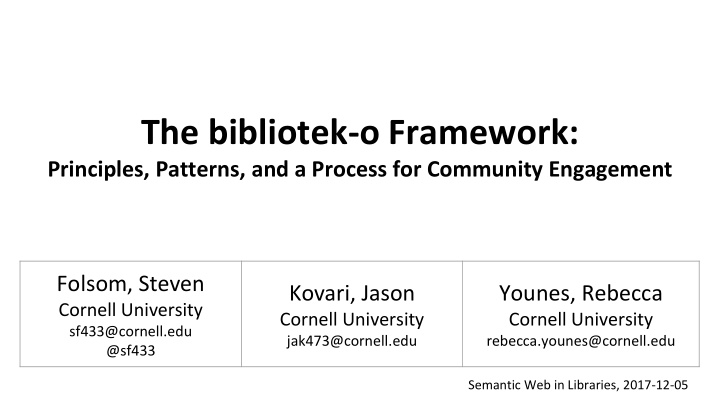



The bibliotek-o Framework: Principles, Patterns, and a Process for Community Engagement Folsom, Steven Kovari, Jason Younes, Rebecca Cornell University Cornell University Cornell University sf433@cornell.edu jak473@cornell.edu rebecca.younes@cornell.edu @sf433 Semantic Web in Libraries, 2017-12-05
bibliotek-o - purpose LD4 Ontology Group's BIBFRAME 2.0 assessment Evaluate Extend Deviate Accommodate
bibliotek-o - documentation Home page: http://bibliotek-o.org/ontology OWL file: http://bibliotek-o.org/ontology.owl Human-readable documentation: http://bibliotek-o.org/ontology.html Visualization: https://bibliotek-o.org/overview/overview.html GitHub repository: https://github.com/ld4l-labs/bibliotek-o/tree/v1.0.1 FAQ, pattern recommendations & RDA discussion: https://wiki.duraspace.org/x/H5TBB
bibliotek-o - principles observed via patterns Activities - Content Accessibility - Content Type, Carrier Type and Media Type - Identifiers - Legacy Literals - Notes and Annotations - Relations - Titles -
bibliotek-o - Activities
BIBFRAME Content/Carrier/Media
bibliotek-o Content/Carrier/Media Committing to subclasses of bf:Work | bf:Instance
bibliotek-o: Relations Design principle: Reuse and align with existing external vocabularies to promote data exchange and interoperability. • Decided to selectively reuse RDAu • BF minimally expressive when relating Works other works, especially derivative works • e.g. P60243 “is free translation of”. • The Relations Pattern document goes into much more detail • Yes, Osma… the opaque RDA URIs and interpreting some of the definitions are a pain ;) but we didn’t want to mint our own properties
SHACL application profiles • Want ontology driven applications, but the ontology definitions alone are not enough • Current use case - Editor Form Specifications • Eventually we’ll want to address general data validationExamples (in progress) • Current Work (in progress) • Hip Hop (https://github.com/LD4P/HipHop/tree/develop/application- profiles) • Moving Image (https://github.com/LD4P/moving- image/tree/develop/application_profiles) • Soon we will organize general shapes in the bibliotek-o github repo (e.g. Titles, Measurement, Subjects, for shared across Domains/Applications)
SHACL Semantics for Form Building • Define shapes to build modular form components* • Property order/grouping (sh:order/sh:group) • Associating properties with Entity types/external data sources (sh:class/sh:target/sh:hasValue) • Display of form fields (sh:name/sh:description) • Cardinality/repeatability (sh:max/sh:min) • Expected node kind (sh:nodeKind defines whether the shape should have a IRI, Literal, or Blank Node) • Extensions to SHACL- nested forms, defining lookups *Fuller draft slide deck with examples: http://bit.ly/2AmC7wC
Leaving time for questions... Please: • Seek us out to discuss any part of our work • Read and comment on our outputs publicly • Share any of your own assessments publicly And... • If you have thoughts process and tools for community owned/transparent ontology management, we would definitely like to talk.
Recommend
More recommend